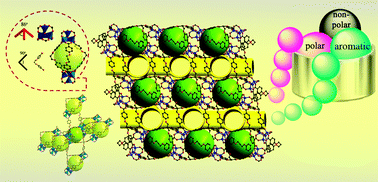Construction of a trigonal bipyramidal cage-based metal–organic framework with hydrophilic pore surface via flexible tetrapodal ligands†
Abstract
A pcu network can be ordered through trigonal bipyramidal

* Corresponding authors
a
State Key Laboratory of Structural Chemistry, Fujian Institute of Research on the Structure of Matter, Chinese Academy of Sciences, Fujian, Fuzhou 350002, P. R. China
E-mail:
rcao@fjirsm.ac.cn
Fax: +86-591-83796710
A pcu network can be ordered through trigonal bipyramidal

 Please wait while we load your content...
Something went wrong. Try again?
Please wait while we load your content...
Something went wrong. Try again?
T. Liu, J. Lü, X. Lin and R. Cao, Chem. Commun., 2010, 46, 8439 DOI: 10.1039/C0CC02496A
To request permission to reproduce material from this article, please go to the Copyright Clearance Center request page.
If you are an author contributing to an RSC publication, you do not need to request permission provided correct acknowledgement is given.
If you are the author of this article, you do not need to request permission to reproduce figures and diagrams provided correct acknowledgement is given. If you want to reproduce the whole article in a third-party publication (excluding your thesis/dissertation for which permission is not required) please go to the Copyright Clearance Center request page.
Read more about how to correctly acknowledge RSC content.
 Fetching data from CrossRef.
Fetching data from CrossRef.
This may take some time to load.
Loading related content
